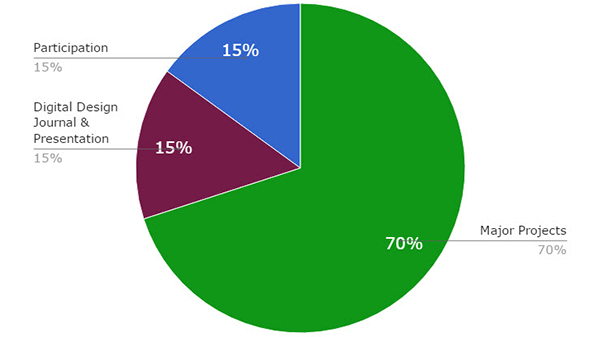Your course grade is comprised of three parts, shown in the chart below. Each portion is described in more detail below the chart.

Major Projects (70% of your course grade)
 You will complete five major projects in this course, along with related drafts and other artifacts. You must complete all five projects to pass the course.
You will complete five major projects in this course, along with related drafts and other artifacts. You must complete all five projects to pass the course.
- Short Video Recording
- Audio Recording
- Long Video Recording
- HTML/CSS Page
- HTML/CSS Site
All these projects will focus on a topic that you choose to explore for the term. Choose something you like and want to investigate or talk about in more detail.
How Grading Works
 Learning how to use images, audio, video, words, space, and design to communicate a message is the most important goal for this course. To accomplish this goal, you will need to work on new things, take risks, and be willing to fail.
Learning how to use images, audio, video, words, space, and design to communicate a message is the most important goal for this course. To accomplish this goal, you will need to work on new things, take risks, and be willing to fail.
A traditional grading system doesn’t work when you focus on these goals. If you are worried about getting an A, you don’t want to try things that could result in failure. Instead, you take safe, easy paths. The grading for this class is meant to eliminate this counterproductive system.
Instead of grading your work for being perfect, I will grade your work for what it shows me about your engagement with the strategies and tools we are using. When you turn your work in, you will tell me about the work you have done, new things you tried, risks you took, and times when you failed (and tried again).
You will either earn a Pass or a Fail grade on the projects you submit. If you receive a Pass, you’re done. That’s it. If you receive a Fail and the grace period is not over, you can revise and resubmit your work. Naturally, if I notice that you are not doing passing work in class, I will let you know (in private, of course). There are no rewrites or revisions after the grace period is over.
Digital Design Journal & Presentation
(15% of your course grade)
 You will keep an online journal of digital designs and give a short, related presentation (15% of your overall course grade). You will submit your journal using the Discussion tool in Canvas, creating a minimum of one entry each week. Your posts will be shared with the class.
You will keep an online journal of digital designs and give a short, related presentation (15% of your overall course grade). You will submit your journal using the Discussion tool in Canvas, creating a minimum of one entry each week. Your posts will be shared with the class.
In your post, you will provide a link or an upload of a digital design that connects to what we have been talking about in class. You will explain how the design demonstrates something we have been talking about and then provide some analytical commentary.
 Once during the semester, you will present a digital design from your journal to the class. You will spend a few minutes telling the class about the design, why you chose it, and how it connects to the class. After you show your design, you will lead a short discussion on the design. You will sign up for these presentations in advance.
Once during the semester, you will present a digital design from your journal to the class. You will spend a few minutes telling the class about the design, why you chose it, and how it connects to the class. After you show your design, you will lead a short discussion on the design. You will sign up for these presentations in advance.
How Grading Works
 Just like major projects, you will either earn a Pass or a Fail grade on the journals you submit and your presentation. If you receive a Pass, you get full credit. If you receive a Fail on a journal and the grace period is not over, you can revise and resubmit. There are no rewrites or revisions after the grace period is over.
Just like major projects, you will either earn a Pass or a Fail grade on the journals you submit and your presentation. If you receive a Pass, you get full credit. If you receive a Fail on a journal and the grace period is not over, you can revise and resubmit. There are no rewrites or revisions after the grace period is over.
Participation (15% of your course grade)
The Work You Need to Do
 Finally, you will participate (15% of your overall course grade) in discussions, peer review, and other informal activities like in-class writing and homework. You will have many opportunities to contribute. The following areas contribute to your participation:
Finally, you will participate (15% of your overall course grade) in discussions, peer review, and other informal activities like in-class writing and homework. You will have many opportunities to contribute. The following areas contribute to your participation:
-
Attendance: You need to be here to participate. If you decide to skip sessions because we are “just working on the projects in class,” your participation grade will suffer.
-
Timeliness: Don’t show up late, leave early, disappear for 15 minutes, and so forth. I want to see you in the classroom and working on the project.
-
Readiness: Be in the classroom and ready to go. Do your homework (including readings), have what you need with you to work, and be prepared to collaborate with classmates.
-
Contributions (In class & online): Ask thoughtful questions, offer specific suggestions, and graciously accept feedback. If it’s hard for you to talk in class, make a point of contributing online.
-
Effort: Participating isn’t simply about talking, but also about working on the activities we do each day. Be focused on the tasks you have been asked to complete.
-
Collegiality: Be supportive of everyone in the classroom and uphold the Principles of Community. In general, be kind and helpful to one another. Help create the kind of community in the classroom that makes you happy to be in class.
 How Grading Works
How Grading Works
You will log your participation, noting where and how you contribute to the on-going conversations in the course, how you support your classmates, and so forth.
For your final exam, you will write a short completion report that explains what you have done and provides a self-evaluation of your participation. You will propose the grade you should receive and then use your log to provide data to support your recommendation.
Participation is calculated on the default Virginia Tech A/F grade scale with +/-.
Choosing Your Work for the Course
You have the freedom to choose the activities you will complete and the grade you will aim for in this course. To pass the course, you MUST complete the five major projects. The rest of your grade is up to you and the goals you set.
If you have questions about your grade potential, make an appointment to see me during office hours. I can’t discuss individual grades in the open classroom because of FERPA regulations. If I believe that you are on a trajectory toward a C, D, or F, I will let you know. If you are participating in the class and doing your work, then you’re passing and just need to be concerned about your individual goals for earning a C, a B or an A.
Here are some possible ways (but not all the ways) you might earn a grade in this course:
To earn an A:
- Complete five projects with a grade of Pass
- Complete 90 to 100% of the Design Journals and your Presentation with a grade of Pass
- Participate in 90 to 100% of the participation activities, showing strong effort
To earn a B:
Scenario One
- Complete five projects with a grade of Pass
- Complete 80 to 89% of the Design Journals and your Presentation with a grade of Pass
- Participate in 80 to 89% of the participation activities, showing good effort
Scenario Two
- Complete five projects with a grade of Pass
- Complete 90 to 100% of the Design Journals and your Presentation with a grade of Pass
- Skip the participation activities
Scenario Three
- Complete five projects with a grade of Pass
- Skip all the Design Journals and the Presentation
- Participate in 90 to 100% of the participation activities, showing strong effort
To earn a C:
Scenario One
- Complete five projects with a grade of Pass
- Complete 70 to 79% of the Design Journals and your Presentation with a grade of Pass
- Participate in 70 to 79% of the participation activities, showing average effort
To earn a C-:
Scenario One
- Complete five projects with a grade of Pass
- Skip all the Design Journals and the Presentation
- Skip the participation activities